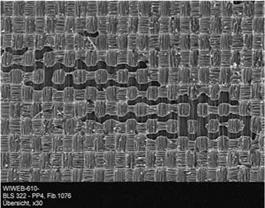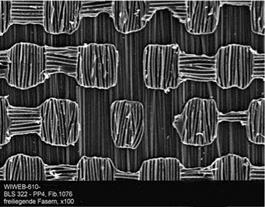One of the problems of adhesive bonding technology is the fact that bonded joints may fail unpredictably when the adherents are contaminated. Even pre-existing contaminations in the form of monolayer adsorbates on the adherent surface prevent a load-carrying intermolecular interaction between the adhesive and the load-bearing adherent. Contaminations induce adhesive failure and poor aging behavior of the bonded joints. With this in mind, it is easy to lose sight of the fact that an inappropriate surface preparation may cause the same symptoms, even in the absence of any contamination. An example of this is the ‘peel ply’ procedure, a method of surface preparation of fiber composite materials (Figure 7.76).
The purpose of the peel ply procedure is thought to generate a laminate surface with good bonding characteristics. For this purpose, during the manufacture of the laminate, a ‘peel ply’ fabric is incorporated into the surface and removed prior to bonding. The main purpose of the fabric is to absorb excess resin material during the curing of the laminate. Consequently, peel ply removal should also be suitable as a
|
Figure 7.76 Insufficient peel ply treatment. |
surface preparation for bonding, because removal of the fabric generates a fresh laminate surface that is activated by the fabric texture and the removal of excess resin. This surface usually has adequate bonding characteristics, without further treatment. The process result is good bond-strength and climate-resistant joints. When the resin is peeled off any superficial contaminations are removed, polymer chain scission is induced in the fractured polymer at resin bridges, and reactive groups are thought to be created on the surface.
Although this surface preparation has proven to be a suitable method for bonding purposes, localized nonsystematic adhesion problems frequently occurred with bonded laminates. This type of damage suggests an influence of the peel ply on the surfaces to be bonded. Surface analysis performed on the delaminated fracture surfaces revealed release agent contamination with considerable localized fluctuations in the degree of contamination. However, on the peel ply, there were no contaminants that would have caused the observed failure pattern, as could be demonstrated by comprehensive surface analysis performed on samples that were randomly selected from peel ply fabric.
The release agent used in the autoclave process was found to be the contaminant detected on the laminate surface after removal of the fabric. The degree of contamination of the laminate surface depends on the degree of resin absorption by the peel ply. In regions with a good resin absorption — that is, with a higher excess of resin in the laminate — a surface with little or no release agent results when the fabric and the resin adhering to it are peeled off, whereas contamination occurs in regions with incomplete resin absorption. In the latter case, peeling off the fabric does not represent an adequate surface preparation because the resin and contaminants are only partially removed (Figure 7.77).
Resin absorption by the peel ply — and consequently the quality and reproducibility of the surface preparation — are determined by several factors. These include the resin content of the composite-fiber fabric preimpregnated with the matrix resin, the processing parameters, and in particular the structure of the laminate (unidirectional,
|
Figure 7.77 Scanning electron microscopy image of a carbon fiber-reinforced polymer (CFRP) surface following incorrect peel ply treatment. |
multidirectional) — that is, by the packing density of the fibers. In unidirectional laminates, a larger amount of excess resin material is available due to the higher packing density ofthe fibers, which induces a decrease in the degree of contamination caused by the release agent. Unidirectional laminates are typically used in destructive testing (tensile test, double cantilever beam test) to investigate and to prove the suitability of surface preparation methods, whereas multidirectional laminates are relevant for practical applications where more matrix resin material is needed for the space between the diagonal fiber layers. This implies a lower excess resin, inducing a higher risk oflocal contaminations with the release agent. Furthermore, a shortage in resin material occurs with decreasing thickness of the laminate. This is especially critical as bonding is the preferred joining technique used for structures with thin walls.
However, the peel ply surface preparation must be regarded as critical for yet another, independent reason. Indeed, due to the deliberately poor adhesion between the resin material and fabric (otherwise, the peel ply could not be removed), the peel ply leaves a negative imprint of its structure on the prepared surface. When coming into contact with the peel ply, and during the curing process in the autoclave, the functional groups of the liquid matrix resin material ‘see’ only a nonbondable surface (see Section 3.2). In the autoclave, consequently, a similar structure with low surface energy is also generated as an interface image on the resin side. This is subsequently uncovered by the peel-off procedure, although unless further surface preparation is performed it does not fulfill the requirements of a surface with excellent, reliable bonding characteristics. The only part ofthe surface that has good bonding characteristics is the region on which fracture surfaces of the resin bridges have been generated during the removal of excess resin.
8
 3 ноября, 2015
3 ноября, 2015  Pokraskin
Pokraskin 

 Опубликовано в рубрике
Опубликовано в рубрике 